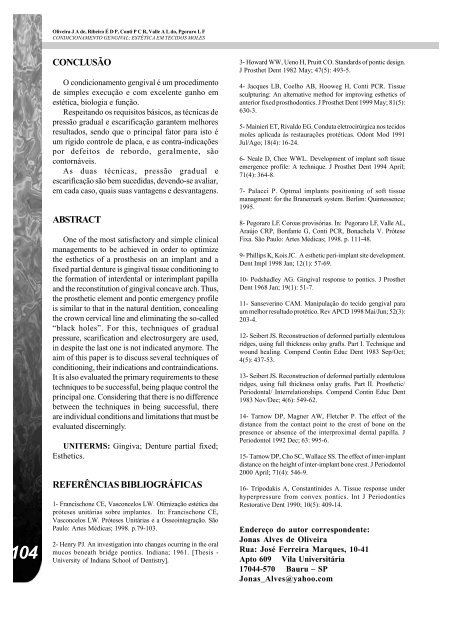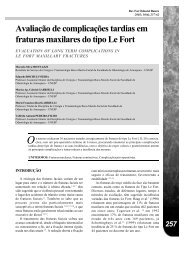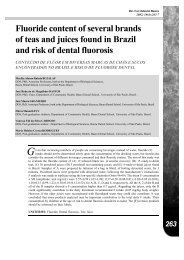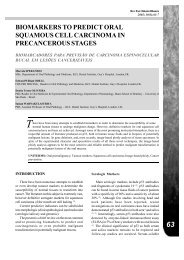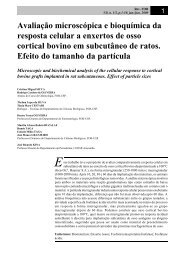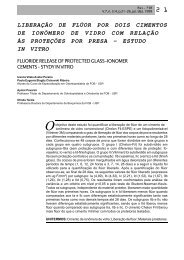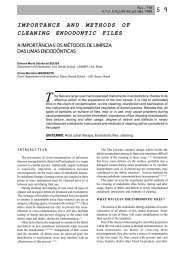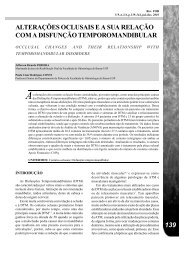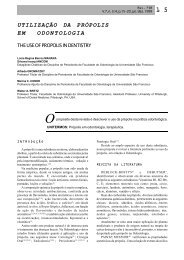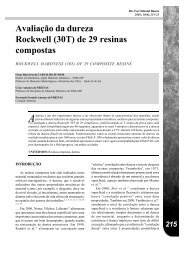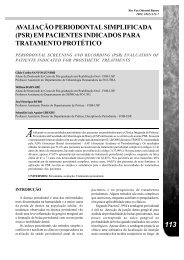CONDICIONAMENTO GENGIVAL: ESTÉTICA EM TECIDOS MOLES
CONDICIONAMENTO GENGIVAL: ESTÉTICA EM TECIDOS MOLES
CONDICIONAMENTO GENGIVAL: ESTÉTICA EM TECIDOS MOLES
You also want an ePaper? Increase the reach of your titles
YUMPU automatically turns print PDFs into web optimized ePapers that Google loves.
Oliveira J A de, Ribeiro É D P, Conti P C R, Valle A L do, Pgoraro L F<br />
<strong>CONDICIONAMENTO</strong> <strong>GENGIVAL</strong>: <strong>ESTÉTICA</strong> <strong>EM</strong> <strong>TECIDOS</strong> <strong>MOLES</strong><br />
104<br />
CONCLUSÃO<br />
O condicionamento gengival é um procedimento<br />
de simples execução e com excelente ganho em<br />
estética, biologia e função.<br />
Respeitando os requisitos básicos, as técnicas de<br />
pressão gradual e escarificação garantem melhores<br />
resultados, sendo que o principal fator para isto é<br />
um rígido controle de placa, e as contra-indicações<br />
por defeitos de rebordo, geralmente, são<br />
contornáveis.<br />
As duas técnicas, pressão gradual e<br />
escarificação são bem sucedidas, devendo-se avaliar,<br />
em cada caso, quais suas vantagens e desvantagens.<br />
ABSTRACT<br />
One of the most satisfactory and simple clinical<br />
managements to be achieved in order to optimize<br />
the esthetics of a prosthesis on an implant and a<br />
fixed partial denture is gingival tissue conditioning to<br />
the formation of interdental or interimplant papilla<br />
and the reconstitution of gingival concave arch. Thus,<br />
the prosthetic element and pontic emergency profile<br />
is similar to that in the natural dentition, concealing<br />
the crown cervical line and eliminating the so-called<br />
“black holes”. For this, techniques of gradual<br />
pressure, scarification and electrosurgery are used,<br />
in despite the last one is not indicated anymore. The<br />
aim of this paper is to discuss several techniques of<br />
conditioning, their indications and contraindications.<br />
It is also evaluated the primary requirements to these<br />
techniques to be successful, being plaque control the<br />
principal one. Considering that there is no difference<br />
between the techniques in being successful, there<br />
are individual conditions and limitations that must be<br />
evaluated discerningly.<br />
UNITERMS: Gingiva; Denture partial fixed;<br />
Esthetics.<br />
REFERÊNCIAS BIBLIOGRÁFICAS<br />
1- Francischone CE, Vasconcelos LW. Otimização estética das<br />
próteses unitárias sobre implantes. In: Francischone CE,<br />
Vasconcelos LW. Próteses Unitárias e a Osseointegração. São<br />
Paulo: Artes Médicas; 1998. p.79-103.<br />
2- Henry PJ. An investigation into changes ocurring in the oral<br />
mucos beneath bridge pontics. Indiana; 1961. [Thesis -<br />
University of Indiana School of Dentistry].<br />
3- Howard WW, Ueno H, Pruitt CO. Standards of pontic design.<br />
J Prosthet Dent 1982 May; 47(5): 493-5.<br />
4- Jacques LB, Coelho AB, Hooweg H, Conti PCR. Tissue<br />
sculpturing: An alternative method for improving esthetics of<br />
anterior fixed prosthodontics. J Prosthet Dent 1999 May; 81(5):<br />
630-3.<br />
5- Mainieri ET, Rivaldo EG. Conduta eletrocirúrgica nos tecidos<br />
moles aplicada às restaurações protéticas. Odont Mod 1991<br />
Jul/Ago; 18(4): 16-24.<br />
6- Neale D, Chee WWL. Development of implant soft tissue<br />
emergence profile: A technique. J Prosthet Dent 1994 April;<br />
71(4): 364-8.<br />
7- Palacci P. Optmal implants positioning of soft tissue<br />
managment: for the Branemark system. Berlim: Quintessence;<br />
1995.<br />
8- Pegoraro LF. Coroas provisórias. In: Pegoraro LF, Valle AL,<br />
Araújo CRP, Bonfante G, Conti PCR, Bonachela V. Prótese<br />
Fixa. São Paulo: Artes Médicas; 1998. p. 111-48.<br />
9- Phillips K, Kois JC. A esthetic peri-implant site development.<br />
Dent Impl 1998 Jan; 12(1): 57-69.<br />
10- Podshadley AG. Gingival response to pontics. J Prosthet<br />
Dent 1968 Jan; 19(1): 51-7.<br />
11- Sanseverino CAM. Manipulação do tecido gengival para<br />
um melhor resultado protético. Rev APCD 1998 Mai/Jun; 52(3):<br />
203-4.<br />
12- Seibert JS. Reconstruction of deformed partially edentulous<br />
ridges, using full thickness onlay grafts. Part I. Technique and<br />
wound healing. Compend Contin Educ Dent 1983 Sep/Oct;<br />
4(5): 437-53.<br />
13- Seibert JS. Reconstruction of deformed partially edentulous<br />
ridges, using full thickness onlay grafts. Part II. Prosthetic/<br />
Periodontal/ Interrelationships. Compend Contin Educ Dent<br />
1983 Nov/Dec; 4(6): 549-62.<br />
14- Tarnow DP, Magner AW, Fletcher P. The effect of the<br />
distance from the contact point to the crest of bone on the<br />
presence or absence of the interproximal dental papilla. J<br />
Periodontol 1992 Dec; 63: 995-6.<br />
15- Tarnow DP, Cho SC, Wallace SS. The effect of inter-implant<br />
distance on the height of inter-implant bone crest. J Periodontol<br />
2000 April; 71(4): 546-9.<br />
16- Tripodakis A, Constantinides A. Tissue response under<br />
hyperpressure from convex pontics. Int J Periodontics<br />
Restorative Dent 1990; 10(5): 409-14.<br />
Endereço do autor correspondente:<br />
Jonas Alves de Oliveira<br />
Rua: José Ferreira Marques, 10-41<br />
Apto 609 Vila Universitária<br />
17044-570 Bauru – SP<br />
Jonas_Alves@yahoo.com


